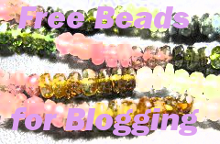top ten ways to use mica powders with polymer clay
Mica powders are very popular with clayers-- one of the top few "extra" materials most of us buy, I'd say. It's no wonder, considering how many things you can do with them and the way that they can turn a ho-hum piece into something shimmering and beautiful.
Top Ten Ways to Use Mica Powders with Polymer Clay:
10. Use it with a stencil.
Place a bought (usually in the paint section of craft stores), found (such as a paper doily), or homemade (cut from cardstock or a thin sheet of plastic) stencil over a piece of clay. (This technique works most easily on flat projects.) Gently tap mica powders (as many as you like) onto the exposed clay. Carefully lift stencil to reveal your pattern.
9. Make a sparkling glaze.
Mix a little mica powder into a small amount of polymer-friendly finish (Future or Varathane) or acrylic medium. (You can mix some in a painter's palette, if you need very little, or use a small paint pot or film canister if you want to make enough to save for another time.) Thin with water to reach desired consistency. Apply over plain or decorated cured polymer clay pieces for an extra touch of sparkle.
8. Crackle it over raw clay.
In order to crackle mica powders, you'll need to mix them into an acrylic medium or polymer-friendly finish. Future Floor Wax works well for this. Mix it (as described above), then paint it onto a sheet of raw polymer clay. Allow the finish to dry, then feed through the pasta machine or roll with a brayer or acrylic rod to produce the crackling effect.
7. Use it in mokume gane.
As described in last week's Top Ten Tuesday, you can use mica powders in mokume gane in a couple of ways. Either apply occasional dabs of it to painted or plain polymer clay sheets, or mix it into Future (etc.) and paint it onto the sheets.
6. Salvage ugly scrap clay.
An unattractive mix of scrap clay (or a color mix gone wrong) can take on a whole new life with an application of mica powder. Just shape the clay and apply the powders before curing. Be aware that certain colors (such as the interference colors) may not completely mask the color of the underlying clay. If in doubt, experiment with a tiny bit of clay and powder.
5. Create faux effects.
Mica powders are useful in a number of faux effects. Metal colors (such as silver or bronze) create an instant appearance of metal. A mix of colors (blue, purple, pink, gold, etc.) "splotchily" blended on black clay imitates the look of raku. Pearl powders make. . . well, pearls. ;o) A touch of these sparkling powders lends a realistic look in a number of faux stone mixes.
4. Tint liquid polymer clay.
Translucent liquid clay can be tinted in a few different ways. Using mica powders as part or all of the colorant gives it a subtle shimmer that's lovely.
3. Tint solid translucent clay.
Translucent clay tinted with mica powders can seem almost to softly glow. Use this mixture "as is" or make a Skinner Blend between two mica-tinted bodies of clay for a ravishing effect.
2. Cover the exterior of a piece.
Using one color or as many as you like, cover an entire piece with mica powders. If you want texture, apply the powder to both the clay and the stamp or texture sheet prior to making the impression. If any portion of the clay remains unpowdered, fill in those spots with the aid of a paintbrush.
1. Highlight textured clay.
For a different look from the "all over sparkle", texture the clay first, then apply mica powders (in however many colors you want) to only the raised portions of the pattern or texture, allowing the clay color to remain visible in the impressions. This can give the appearance of antiqued metal.
Remember: Most mica powders require a coat of polymer-friendly finish (such as Future or Varathane) to prevent the powder from rubbing away-- particularly if the piece will be worn or handled. If you've mixed the powders into Future, Varathane, or another polymer-friendly finish, the extra coat is unneccessary, unless you want more layers for protection or added shine.














































No comments:
Post a Comment
Hi there and welcome to my blog. Thank you for your interest in my post. I look forward to your opinion. Thank you for leaving a comment. bye for now, Jacqueline